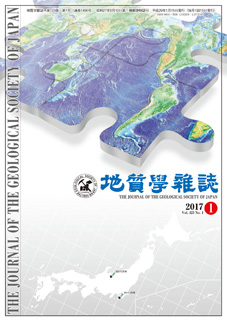
- |<
- <
- 1
- >
- >|
-
Kazuo Kaneko, Mitsuhiro Nagata, Yoshikazu Kouchi, Koshi Yamamoto, Shig ...2019Volume 125Issue 11 Pages 781-792
Published: November 15, 2019
Released on J-STAGE: March 26, 2020
JOURNAL FREE ACCESS
Supplementary materialThe Futomiyama Group is mainly distributed in the southwestern (type locality area) and northeastern (Uozu area) parts of Toyama Prefecture, central Japan, and contains acid volcanic rocks. Despite intensive study, there are no zircon U-Pb ages for the acid volcanic rocks. Here we present the results of laser ablation-inductively coupled plasma-mass spectrometry zircon U-Pb analyses of four acid rocks from the Futomiyama Group in the type locality and Uozu areas. The 238U-206Pb weighted-mean ages are as follows: 70.2±0.7 Ma for tuff and 66.7±0.9 Ma for intrusive rocks in the type locality area; and 70.0±0.5 Ma for welded tuff and 70.6±1.1 Ma for tuff in the Uozu area. Although the Futomiyama Group was thought to be Paleogene in age, our results clarify that it belongs to the uppermost Cretaceous (Maastrichtian).
View full abstractDownload PDF (5095K) -
Geotectonic evolution of the Ultra-Tamba and Tamba terranes, and strike-slip inversion of the Kanbayashigawa FaultMasao Kametaka, Yoshiaki Sugamori, Naoto Ishida, Kazuo Matsui, Hiroki ...2019Volume 125Issue 11 Pages 793-820
Published: November 15, 2019
Released on J-STAGE: March 26, 2020
JOURNAL FREE ACCESSThe geological structure and tectonic evolution of the Paleozoic-Mesozoic accretionary complexes of the Ultra-Tamba and Tamba terranes in the Maizuru and Obama districts in SW Japan were clarified through geological surveys and investigations of fault rocks. A detailed geological map was created by precise field surveys and compilation of past investigation results. Based on the new geological map, we discuss the geotectonic history of the study area.
The Ultra-Tamba terrane, consisting of a late Permian-possibly Triassic accretionary complex, is subdivided into the Kozuki, Oi, and Hikami formations. The Kozuki Formation is newly identified in the study area and occurs sporadically along the boundary between the Yakuno Ophiolitic Complex of the Maizuru terrane and the Oi Formation of the Ultra-Tamba terrane. The Tamba terrane comprises mainly an Early-Late Jurassic accretionary complex and is subdivided into the Shuzan, Kumogahata, Haiya, Tsurugaoka, and Yuragawa complexes, and the Furuya Formation.
The complexes are separated by thrust faults, each comprising a single nappe, and display an imbricate nappe structure as a whole. Layer-parallel, brittle-ductile deformation structures are predominant in the Ultra-Tamba terrane and the Shuzan Complex of the Tamba terrane. These complexes were folded along E-W trending vertical axial planes during the Early Cretaceous. The Kanbayashigawa Fault is characterized by a NE-SW trending cataclastic shear zone with a sinistral shear sense that formed under a paleo-stress field cut-off at these fold structures. The southwestern part of this fault has been reactivated with a dextral shear sense under the current stress field. This slip-sense inversion resulted from the conversion of the stress-field and/or the rotation of regional blocks, and the opening of the Sea of Japan played an important role in the reactivation and slip-sense inversion of old fault structures in SW Japan.
View full abstractDownload PDF (8897K)
-
Hiroyuki Hoshi2019Volume 125Issue 11 Pages 821-825
Published: November 15, 2019
Released on J-STAGE: March 26, 2020
JOURNAL FREE ACCESSThis paper presents a paleomagnetic test for the correlation of tephra over large areas. A recent preliminary investigation suggests the possibility, based mainly on geochemical data, that the Pliocene Wakebe tephra in the lower Kameyama Formation of the Tokai Group is correlative with a widespread tephra in central Japan that was deposited in a normal polarity subchron of the Gauss Chron (C2An). Here, new paleomagnetic data are presented to show that reverse polarity remanent magnetizations are recorded in the Wakebe tephra and in siltstones located immediately above and below the tephra. The results do not support the preliminary correlation of the Wakebe tephra with the widespread tephra of normal polarity, and correlation with this tephra needs to be reconsidered. The Wakebe tephra was deposited between ~3.95 Ma (age of the underlying Akogi tephra) and 3.596 Ma (Gauss-Gilbert boundary age) in the late Gilbert Chron (C2Ar).
View full abstractDownload PDF (738K)
-
Taishi Sugimoto, Tetsuya Tokiwa, Yusuke Shimura2019Volume 125Issue 11 Pages 827-832
Published: November 15, 2019
Released on J-STAGE: March 26, 2020
JOURNAL FREE ACCESS
Supplementary materialU-Pb dating of detrital zircons was undertaken for three sandstone samples of the accretionary complex in the Chichibu Belt, central Akaishi Mountains, central Japan. The youngest single-grain ages are 170.1±2.3 Ma (1σ), 158.2±1.5 Ma, and 159.9±4.2 Ma. The weighted-mean ages of the youngest clusters are 176.7±1.2 Ma, 166.2±1.3 Ma, and 163.7±0.9 Ma. These youngest single-grain and cluster ages lie in the Toarcian to Kimmeridgian during the Jurassic. Therefore, the terrigenous clastic sediments of the accretionary complex in the Chichibu Belt in this area were deposited in the Toarcian or later.
View full abstractDownload PDF (2067K)
-
substance identification and comparison based on microscopic observationHiroki Hongo, Kotaro Takechi, Shinichi Hirono2019Volume 125Issue 11 Pages III-IV
Published: November 15, 2019
Released on J-STAGE: March 26, 2020
JOURNAL FREE ACCESSDownload PDF (4016K)
- |<
- <
- 1
- >
- >|